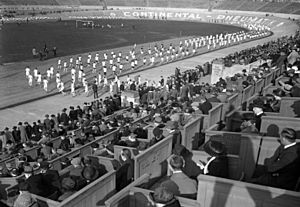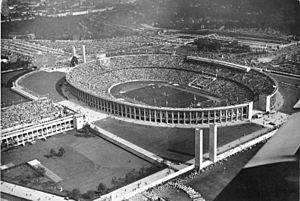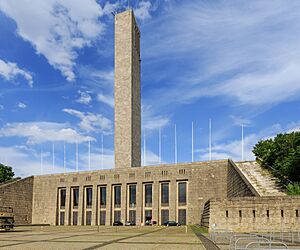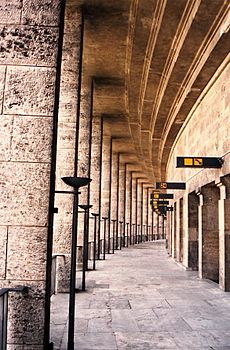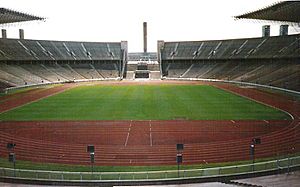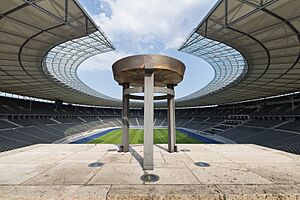Olympiastadion (Berlin) facts for kids
 |
|
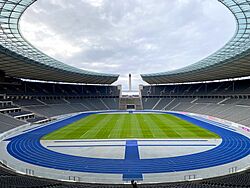
|
|
| Full name | Olympiastadion Berlin |
|---|---|
| Former names | Deutsches Stadion |
| Location | Westend, Charlottenburg-Wilmersdorf, Berlin, Germany |
| Public transit | Olympia-Stadion (U-Bahn) Olympiastadion (S-Bahn) |
| Owner | Government of Berlin |
| Operator | Olympiastadion Berlin GmbH |
| Executive suites | 65 |
| Capacity | 74,475 |
| Field size | 105 × 68 m |
| Surface | Grass |
| Construction | |
| Built | 1934–1936 |
| Opened | 1 August 1936 |
| Renovated | 1974 (reconfiguration) 2000–2004 (World Cup) |
| Construction cost | 43 million ℛℳ (1936) €297 million (2016) |
| Architect | Werner March/Albert Speer (1936) Friedrich Wilhelm Krahe (1974) |
| Tenants | |
| Hertha BSC (1963–1986, 1988–present) 1. FC Union Berlin (2021, 2023) Germany national team (selected matches) SC Tasmania 1900 Berlin (1965–1966) Tennis Borussia Berlin (1974–1975, 1976–1977) Blau-Weiß 1890 Berlin (1984–1990) Berlin Thunder (2003–2007) |
|
The Olympiastadion (which means Olympic Stadium in German) is a famous sports stadium in Berlin, Germany. It's located in the Olympiapark Berlin area. This stadium was first designed by Werner March for the 1936 Summer Olympics.
After big renovations in 2004, the Olympiastadion can now hold 74,475 people. This makes it the largest stadium in Germany for international football matches. It's also a top-rated stadium by UEFA, which is Europe's football governing body.
Besides hosting athletics, the stadium has a long history with football. Since 1963, it has been the home ground for the Hertha BSC football team. It hosted matches in the 1974 FIFA World Cup and was renovated for the 2006 FIFA World Cup, where it even held the final match. The DFB-Pokal final, a major German cup competition, has been played here every year since 1985. The Olympiastadion also hosted games for the 2011 FIFA Women's World Cup and the 2015 UEFA Champions League final. In 2024, it hosted six games for UEFA Euro 2024, including the final.
Contents
History of the Olympiastadion
Early Plans: Deutsches Stadion (1916–1934)
Berlin was chosen to host the 1916 Summer Olympics. The stadium planned for this event was called the Deutsches Stadion. It was going to be built in the Grunewald Forest area. An architect named Otto March designed it to be built partly underground.
However, the 1916 Olympic Games were cancelled because of World War I. Later, in the 1920s, a sports school called the "Deutsches Sportforum" was built nearby. Otto March's sons, Werner and Walter, helped build more parts for this school.
Building the Olympiastadion (1936–1945)
In 1931, Berlin was chosen again to host the 1936 Summer Olympics. At first, the plan was just to fix up the old Deutsches Stadion. But when a new government came to power in 1933, they decided to build a brand new, much larger sports complex.
This new complex was called the "Reichssportfeld" and included the new Olympiastadion. Werner March was still the main architect, working with his brother Walter. The construction happened between 1934 and 1936. The stadium was built on the foundations of the old Deutsches Stadion, with its lower half dug 12 meters (about 39 feet) into the ground.
When it was finished, the Olympiastadion could hold 110,000 spectators. It also had a special area for VIPs. At one end, there was the Marathon Gate, which held the Olympic Flame.
The Maifeld Area
The Maifeld, or Mayfield, was a huge grassy area next to the stadium. It was used for large public events and sports demonstrations. It could hold up to 250,000 people, with stands for 60,000 at its western end.
Underneath the Maifeld stands was the Langemarck-Halle. This hall had pillars with flags and shields. The Bell Tower, which we'll talk about next, was also in this area. During the 1936 Olympics, the Maifeld hosted polo and horse riding events.
After World War II, the British Army used the Maifeld for their annual celebrations and various sports, including cricket.
The Bell Tower
The Bell Tower stood 77 meters (about 253 feet) tall at the western end of the sports complex. From its top, you could see all of Berlin. During the Olympics, it was used by officials and the media.
Inside the tower was the Olympic Bell. It had the Olympic rings, an eagle, the year 1936, and a message: "I call the youth of the world."
Sadly, the Bell Tower was the only part of the complex that was destroyed during World War II. It was used to store archives, which were set on fire by Soviet troops. The fire badly damaged the tower. In 1947, British engineers had to demolish it. The Olympic Bell fell and cracked, so it couldn't ring anymore. It's now a memorial.
The tower was rebuilt exactly as it was before, from 1960 to 1962, by Werner March again. Today, it's a popular spot for tourists to enjoy amazing views of Berlin and the surrounding areas. The Olympiastadion itself survived the war almost untouched, with only minor damage from machine gun fire.
West Berlin Era (1945–1990)
After World War II, the British military used the former sports complex as their headquarters. They fixed up damaged buildings and used them for their needs. From 1951 to 2005, a giant antenna on the Olympischer Platz broadcast radio signals across Berlin.
The British forces continued to hold annual celebrations on the Maifeld. During the 1960s, American football was introduced to Berliners with exhibition games at the stadium.
During these years, the Olympiastadion was the home for Bundesliga football matches, with Hertha BSC as the local team. Other sports like rugby and polo were also played on the Maifeld. The Waldbühne amphitheater hosted classical music concerts and movies.
Reunified Berlin and Modern Renovations (1990–Present)
After the Berlin Wall came down in 1989, people in Berlin discussed what to do with the Olympiastadion. Some wanted to tear it down, while others wanted to keep its history. In the end, they decided to renovate it.
FIFA chose the stadium as one of the venues for the 2006 FIFA World Cup. A big renovation project started on July 3, 2000. The stadium was officially reopened on July 31, 2004, with celebrations and concerts by artists like Pink and Nena.
Since then, the Olympiastadion has become a multi-purpose arena. From 2003 to 2007, it was home to the Berlin Thunder American football team. In 2011, it hosted the World Culture Festival, where 70,000 people meditated for peace. In 2018, it hosted the 2018 European Athletics Championships. In 2024, it hosted the UEFA Euro 2024 final. The stadium will also host an NFL International Series game in 2025.
Stadium Renovation Details
To make football games feel more exciting, the playing field was lowered by 2.65 meters (about 8.7 feet). This meant digging out a lot of sand. The lower seating area was completely rebuilt with a new, steeper angle.
A new roof was added, covering 37,000 square meters (about 398,000 square feet). This roof is supported by 20 columns and is made of clear panels, letting sunlight in. The part of the roof over the Marathon Arch is open, so you can still see the Bell Tower.
It was important to keep the stadium's historical look, especially its natural stone blocks. The athletics track, which used to be red, was changed to blue to match the colors of the Hertha BSC team.
The renovations cost €242 million. The stadium now has modern lighting and sound systems, 113 VIP stands, restaurants, and two underground parking garages.
Stadium Capacity
The Olympiastadion has the highest number of seats in Germany, with a permanent capacity of 74,475 seats. The upper level has 31 rows of seats, and the lower level has 42 rows.
For some big football matches, like those involving Hertha BSC and FC Bayern München, extra seats can be added over the Marathon Arch. This can increase the capacity to 76,197 seats.
Other large stadiums in Germany, like Signal Iduna Park in Dortmund and Allianz Arena in Munich, have standing areas. The Olympiastadion has more all-seated capacity than these stadiums.
Home Team: Hertha BSC
The Olympiastadion has been the home stadium for the 2. Bundesliga club Hertha Berlin since 1963. Hertha BSC played its first match here on August 24, 1963.
Hertha BSC has had its ups and downs. In 1965, the team was moved to a lower league. They returned to the top division in 1968. In the 1970s, Hertha BSC was quite successful, reaching the semi-finals of the UEFA Cup and the finals of the DFB-Pokal twice.
In the 1980s, the team struggled and even moved to a smaller stadium for a while. But they recovered and returned to the Olympiastadion. Other teams like Tasmania, Tennis Borussia, and Blau-Weiß 90 have also used the stadium. 1. FC Union Berlin played some of their European matches here in 2021 and 2023 because their own stadium didn't meet UEFA's requirements.
The DFB-Pokal final has been held at the Olympiastadion every year since 1985. After the Berlin Wall fell in 1989, Hertha BSC played a friendly match against 1. FC Union Berlin from East Berlin, which drew 50,000 fans. Since 1997, Hertha BSC has improved, even playing in the UEFA Champions League against famous European teams.
Major Events at the Stadium
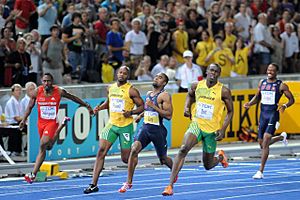
The Olympiastadion has hosted many important events. It once held the world record for attendance at a baseball game during the 1936 Olympics, with over 100,000 people.
It also hosts the annual Internationales Stadionfest, a major athletics event, since 1937. In 2009, the stadium hosted the 2009 World Championships in Athletics, where Usain Bolt broke world records in the 100 and 200 meters.
1936 Summer Olympics
The 1936 Summer Olympics officially began on August 1, 1936. The Olympic cauldron was lit by athlete Fritz Schilgen. Four million tickets were sold for all the events. This was the first Olympics to have television broadcasts, with 25 viewing areas around Berlin.
A new tradition started at these Olympics: the Olympic torch relay. The torch traveled 3,000 kilometers (about 1,864 miles) from Olympia in Greece, through several countries, to Berlin.
One of the most famous athletes at these games was Jesse Owens, an African-American track and field star from the United States. Owens won four gold medals in the 100 meters, 200 meters, long jump, and 4 × 100 relay. A street outside the stadium is now named Jesse Owens Allee to honor his achievements. The stadium also hosted horse riding, football, and handball events.
1974 FIFA World Cup Group A
The Olympiastadion hosted three matches from Group A of the 1974 FIFA World Cup. These matches involved Chile. One match, between Australia and Chile, was played in heavy rain. West Germany, the host country, went on to win the tournament.
| Team | Pts | Pld | W | D | L | GF | GA | GD |
|---|---|---|---|---|---|---|---|---|
| 5 | 3 | 2 | 1 | 0 | 4 | 1 | 3 | |
| 4 | 3 | 2 | 0 | 1 | 4 | 1 | 3 | |
| 2 | 3 | 0 | 2 | 1 | 1 | 2 | −1 | |
| 1 | 3 | 0 | 1 | 2 | 0 | 5 | −5 |
| Date | Team #1 | Result | Team #2 | Round | Attendance |
|---|---|---|---|---|---|
| 14 June 1974 | 1–0 | First Round, Group A | 81,100 | ||
| 18 June 1974 | 1–1 | 28,300 | |||
| 22 June 1974 | 0–0 | 17,400 |
2006 FIFA World Cup Matches
The Olympiastadion hosted six matches during the 2006 FIFA World Cup, including the final game.
| Date | Time (CEST) | Team #1 | Result | Team #2 | Round | Spectators |
|---|---|---|---|---|---|---|
| 13 June 2006 |
|
|
|
72,000 | ||
| 15 June 2006 |
|
|
|
72,000 | ||
| 20 June 2006 |
|
|
|
72,000 | ||
| 23 June 2006 |
|
|
|
72,000 | ||
| 30 June 2006 |
|
|
|
72,000 | ||
| 9 July 2006 |
|
|
|
69,000 |
2011 FIFA Women's World Cup
In 2011, the Olympiastadion hosted Germany's first match in the 2011 FIFA Women's World Cup. It was the only game of the tournament played at this stadium.
| Date | Time (CEST) | Team #1 | Result | Team #2 | Round | Spectators |
|---|---|---|---|---|---|---|
| 26 June 2011 |
|
|
|
73,680 |
2015 UEFA Champions League Final
In May 2013, the Olympiastadion was chosen to host the 2015 UEFA Champions League Final. FC Barcelona won their fifth title in this exciting match.
| 6 June 2015 20:45 CEST |
Juventus |
1–3 | Olympiastadion, Berlin Attendance: 70,442 Referee: Cüneyt Çakır (Turkey) |
|
|---|---|---|---|---|
| Morata |
https://www.uefa.com/uefachampionsleague/season=2015/matches/round=2000552/match=2015227/index.html | Rakitić Suárez Neymar |
2023 Special Olympics World Summer Games
On June 17, 2023, the Olympiastadion hosted the opening ceremony for the 2023 Special Olympics World Summer Games. This event brought together athletes with intellectual disabilities from around the world.
UEFA Euro 2024 Matches
The Olympiastadion hosted six matches for UEFA Euro 2024, including a round of 16 game, a quarter-final, and the final match on July 14, 2024.
| Date | Time (CEST) | Team #1 | Result | Team #2 | Round | Spectators |
|---|---|---|---|---|---|---|
| 15 June 2024 |
|
|
|
68,844 | ||
| 21 June 2024 |
|
|
|
69,455 | ||
| 25 June 2024 |
|
|
68,363 | |||
| 29 June 2024 |
|
|
|
68,172 | ||
| 6 July 2024 |
|
|
|
70,091 | ||
| 14 July 2024 |
|
|
|
65,600 |
NFL International Germany Game
The stadium has also hosted American football games. It was home to the Berlin Thunder team from 2003 to 2007. The National Football League (NFL) returned to the stadium on November 9, 2025, for an NFL International Series game between the Indianapolis Colts and the Atlanta Falcons.
| Year | Date | Designated
visitor |
Score | Designated
home team |
Score | Stadium | City | Attendance |
|---|---|---|---|---|---|---|---|---|
| 2025 | November 9 | Atlanta Falcons | Indianapolis Colts | Olympiastadion | Berlin |
Concerts and Other Events
The Olympiastadion is not just for sports; it also hosts many concerts and other large events. Famous musicians from around the world have performed here.
Getting to the Stadium
It's easy to get to the Olympiastadion using public transport in Berlin.
U-Bahn (Underground Train)
The U2 underground train line takes you directly to the Olympia-Stadion station. From there, it's a short walk to the stadium entrances. The journey takes about 14 minutes from Zoologischer Garten.
S-Bahn (Suburban Rail)
The S3 and S9 suburban rail lines go directly to the Olympiastadion station. This is a very short walk to the stadium. It takes about 14 minutes from Zoologischer Garten. For big events, special trains often run to this station.
Bus Services
You can also take bus lines M49 and 218 to the Flatowallee stop, which is a short walk away. Bus line 143 goes to the Neu-Westend underground station, from where there's a path to the stadium.
See also
 In Spanish: Estadio Olímpico de Berlín para niños
In Spanish: Estadio Olímpico de Berlín para niños
- Berlin
- Football in Berlin
- Sport in Berlin
- Lists of stadiums


